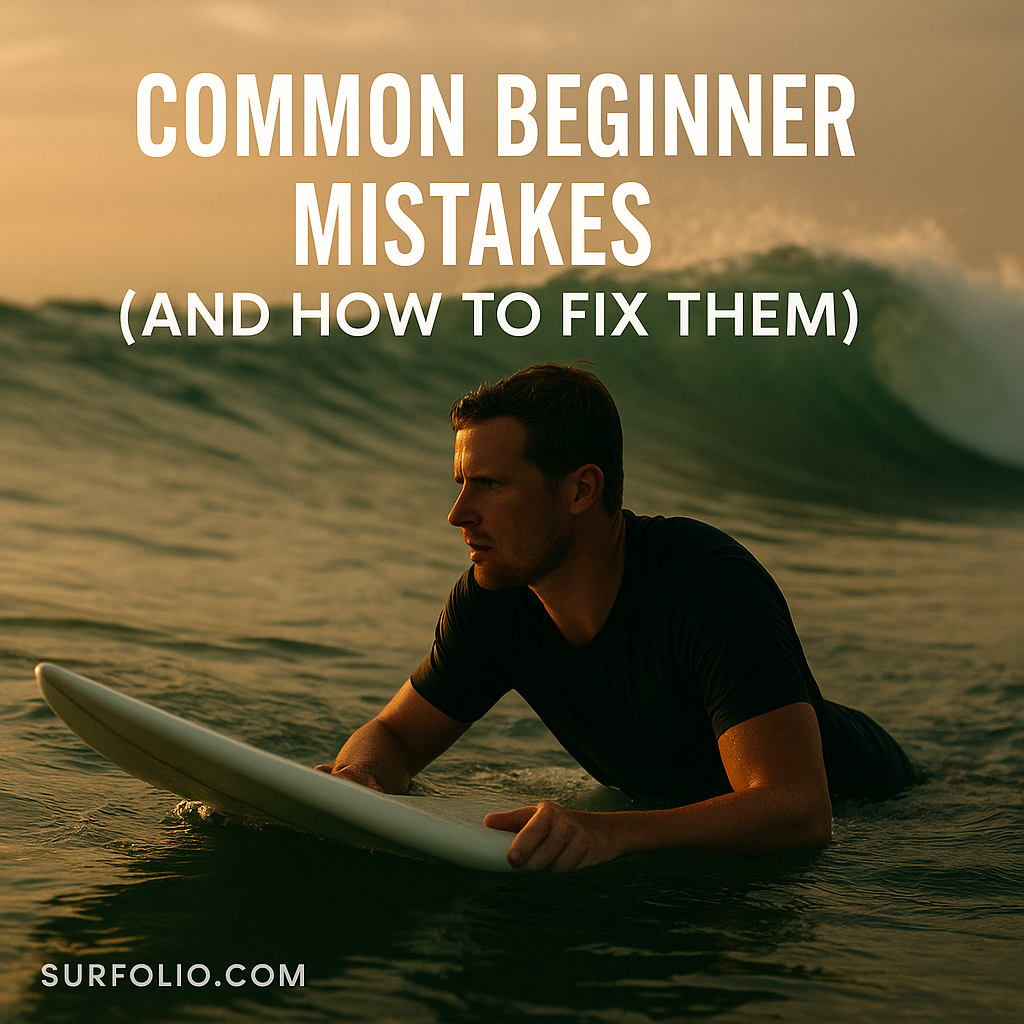
Surfing looks effortless when done right—but every pro was once a beginner wiping out on the inside. Learning to surf is about trial, error, and persistence, but avoiding a few common mistakes can fast-track your progress and keep you safer in the water.
Here are the most common beginner mistakes—and exactly how to fix them so you can catch more waves and build confidence faster.
1. Paddling in the Wrong Spot
The Mistake: Sitting too far inside (where waves break on your head) or too far outside (where waves roll under you).
Why It Happens: New surfers often can’t yet read where the waves are peaking or losing energy.
How to Fix It:
- Watch the lineup for a few minutes before paddling out.
- Identify where experienced surfers are catching waves.
- Adjust your position gradually instead of constantly paddling around.
Learning to read waves is half the battle—and comes with time and observation.
2. Poor Paddling Technique
The Mistake: Paddling with short, choppy strokes or lifting the chest too high off the board.
Why It Happens: Many beginners overuse their arms and waste energy before even catching a wave.
How to Fix It:
- Keep your body centered and low on the board.
- Use long, deep strokes that reach forward and pull smoothly through the water.
- Relax—smooth paddling is faster than frantic paddling.
Your board glides best when you move efficiently, not forcefully.
3. Looking Down During Takeoff
The Mistake: Staring at your feet or board while popping up.
Why It Happens: Natural instinct—your brain wants to check if you’re balanced.
How to Fix It:
- Keep your eyes up and forward, looking where you want to go.
- Your head leads your body—if you look down, you’ll fall down.
Confidence in your stance starts with trust in your takeoff.
4. Standing Too Early (or Too Late)
The Mistake: Popping up before the wave picks you up—or waiting too long and missing it.
Why It Happens: Beginners struggle to time the wave’s energy and acceleration.
How to Fix It:
- Paddle hard and feel the wave lift your board.
- As soon as you feel momentum, pop up quickly in one smooth motion.
- If you miss it, analyze—were you too early, too late, or too far back?
Timing takes repetition, but when it clicks, your rides get exponentially better.
5. Poor Foot Placement
The Mistake: Feet too close together or too far forward on the board.
Why It Happens: Popping up feels chaotic at first, so balance becomes guesswork.
How to Fix It:
- Practice your pop-up on land to build muscle memory.
- Aim for your front foot to land near the center of the board, back foot over the fins.
- Keep a shoulder-width stance and knees bent.
A balanced stance gives you both control and speed.
6. Not Using the Rails
The Mistake: Riding straight toward shore instead of angling along the wave.
Why It Happens: It feels safer to go straight, but you’ll outrun the wave or lose speed.
How to Fix It:
- Angle slightly toward the shoulder as you pop up.
- Use your eyes and shoulders to guide your direction.
- Start small—just a few degrees off straight, then build more angle as you improve.
Learning to ride across the wave unlocks real surfing.
7. Ignoring Ocean Awareness
The Mistake: Not paying attention to other surfers, currents, or wave sets.
Why It Happens: Beginners focus entirely on themselves, not their surroundings.
How to Fix It:
- Always look both ways before paddling for a wave.
- Learn to spot rips, rocks, and shifting peaks.
- Respect lineup etiquette—don’t drop in on others or paddle into their path.
Ocean awareness keeps you safe and earns respect from other surfers.
8. Giving Up Too Soon
The Mistake: Getting frustrated after a few wipeouts or missed waves.
Why It Happens: Surfing has a steep learning curve, and progress can feel slow.
How to Fix It:
- Celebrate small wins—like paddling into a wave or holding balance longer.
- Remember: every wipeout teaches you something.
- Consistency beats intensity. Surf regularly, even for short sessions.
The best surfers aren’t fearless—they’re persistent.
9. Using the Wrong Board
The Mistake: Starting on a shortboard because it “looks cool.”
Why It Happens: Beginners underestimate how much easier learning is on the right board.
How to Fix It:
- Use a soft-top longboard (8–9 feet) to start.
- Bigger boards catch waves earlier and help you master balance and control.
- Transition to smaller boards once you can paddle, pop up, and turn comfortably.
A forgiving board equals faster progress and fewer frustrations.
Final Thoughts
Every surfer makes mistakes—it’s part of the journey. What matters is how quickly you learn from them.
Stay patient, stay observant, and stay humble. The ocean rewards persistence and awareness more than perfection.
So the next time you wipe out, smile—you’re just one mistake closer to getting it right.
